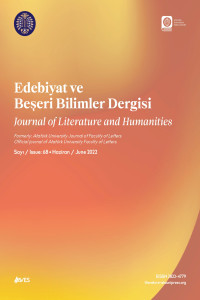GELENEKTEN GELECEĞE: ERNST JUNGER’İN GLÄSERNE BIENEN ADLI ESERİNDE DİSTOPİK KURGU
Geçmiş çağları geride bırakıp artık “Milenyum Çağı” adı verilen bir dönemde yaşıyor olduğumuz gerçeği, gerek edebiyat alanında gerekse diğer bilim dallarında bazı yeniliklere gidilmesi ihtiyacını doğurur. Nitekim bu yeniçağda değişen yalnızca doğa olayları, şehir panoramaları ya da yaşam formları değildir. Teknolojik gelişmeler, toplum yapısını köktenci olarak değiştiren sosyolojik yenilenmeler ve siyasal reformlar, insanoğlunu yeni bir dünya algısı ile karşı karşıya getirir. Yeni Dünya’yı algılama çabası, distopya gibi bazı yeni kavramların filizlenmesine öncülük eder. Thomas More’un ilk kez kullandığı ve ideal bir toplum oluşturma ülküsü taşıyan “ütopya”sına karşıt olarak John Stuart Mill’in dillendirdiği distopya kavramı, kötü bir geleceğe işaret eder. Çalışmada, Alman yazar Ernst Jünger’in 1957 yılında yayımladığı Gläserne Bienen adlı eseri ekseninde bir distopik roman incelenmesi amaçlanmaktadır ve eserler metin odaklı yöntemle birlikte nitel araştırma yöntemi kullanılarak irdelenecektir.
Anahtar Kelimeler:
Distopya, Distopik Roman, Ernst Jünger, Geçmiş, Gelecek
From The Past to The Future: Dystopian Fiction in Ernst Junger’s Glass Bees
The fact that we are now living in a period which is called the ‘Millennium Age’ which has long outstripped the past periods requires that certain innovations be made in both the area of literature and in the other areas of science. In fact, what changes in this new age are not only natural events, city panoramas or life forms. Technological developments, sociological innovations which radically change the structure of society and political reforms bring humankind face to face with a brand new perception of the world. The attempt to perceive the New World leads to the budding of some new concepts such as dystopia. The concept of dystopia which was first expressed by john Stuart Mill versus ‘utopia’ which was first used by Thomas More with the ideal of forming an ideal society points out to a bad future. In the study, it is aimed at analyzing a dystopian novel in the axis of German writer Ernst Jünger’s work Gläserne Bienen (Glass Bees) dated 1957 and the work will be studied through a qualitative research method together with a text centered method.
Keywords:
Dystopia, Dystopian Novel, Ernst Jünger, The past, The future,
___
- Ademoğlu, A. (1996). “Heideger'in Modernlikle Yüzleşmesi”. Divan: Disiplinlerarası Çalışmalar Dergisi, (1), s. 175-183.Baker, U. (2018). Yüzeybilim-Fragmanlar. 4. Baskı. İstanbul: İletişim Yayınları.Basu, B.; Broad, K. R.; Hintz, C. (Ed.). (2013). Contemporary Dystopian Fiction for Young Adults: Brave New Teenagers. New York: Routledge.Boynukalın, R. (2017). “Performans Sanatçısı Olarak Arılar ve Enstalasyon Olarak Kovanlar”. ulakbilge, 5(13), s. 1067-1089.Burns, T. (2008). Political Theory, Science Fiction, and Utopian Literature: Ursula K. Le Guin and The Dispossessed. UK: Lexington Books.Çelik, E. (2015). “Distopik Romanlarda Toplumsal Kurgu”. Sosyoloji Araştırmaları Dergisi, 18(1), s. 57-79.Elias, N. (1982). “Staatkritik’. Mit Überlegungen zur Bestimmung des Begriffs Utopie”. In: Vosskamp, W. (Hg.). (1982). Utopieforschung. Interdisziplinäre Studien zur neuzaitlichen Utopie. B.2. Stuttgart: Metzler.Fioretti, D. (2017). Utopia and Dystopia in Postwar Italian Literature: Pasolini, Calvino, Sanguineti, Volponi. Switzerland: Springer International Publishing AG.Hawkins-Day, M. (Ed.). (2012). Reader's Guide to Literature in English, New York: Routledge. Jameson, F. (2005). Archaeologies of the Future: The Desire Called Utopia and Other Science Fictions. New York: Verso.Jünger, E. (1957). Gläserne Bienen. Stuttgart: Ernst Klett Verlag. Kotin, A. (2017). “Alfred Kubins: Die andere Seite ald Deutsche Antiutophie der Jahrhunderte”. In: Wałowski, P. (Hg.). (2017). Der (neue) Mensch und seine Welten: Deutschsprachige fantastische Literatur und Science-Fiction. Berlin: Frank & Timme GmbH.Mair, M. (2015). Erzähltextanalyse [German-language Edition]: Modelle, Kategorien, Parameter. Stuttgart: ibidem-verlag. Nevin, T. (1996). Ernst Jünger and Germany: Into the Abyss, 1914-1945. Durham: Duke University Press.Petzi, M.; Kattwinkel, S. (2016). Das Gesunde Unternehmen zwischen Utopie und Dystopie: Betriebliches Gesundheitsmanagement auf dem Prüfstand. Wiesbaden: Springer Verlag.Roth, M. S. (2012). Memory, Trauma, and History: Essays on Living with the Past. New York: Columbia University Press.Schöning, M. (Hg.). (2014). Ernst Jünger-Handbuch: Leben – Werk – Wirkung. Stuttgart: Springer Verlag GmbH.Segeberg, H. (2000). “Ernst Jüngers Gläserne Bienen Als Frage Nach Der Technik”. In: Strack, F. (Hg.). (2000). Titan Technik: Ernst und Friedrich Georg Jünger über das technische Zeitalter. Würzburg: Verlag Königshausen & Neumann GmbH.Suerbaum, U.; Broich, U.; Borgmeier, R. (1981). Science fiction: Theorie und Geschichte, Themen und Typen, Form und Weltbild. Stuttgart: Reclam.Weber, S. (2104). Dystopie und Utopie bei Christian Kracht: „Ich werde hier sein im Sonnenschein und im Schatten“, „Metan“ und „Imperium“. Hamburg: Diplomica Verlag GmbH. Zeißler, E. (2009). Dunkle Welten: die Dystopie auf dem Weg ins 21. Jahrhundert. Marburg: Tectum Verlag.
- Yayın Aralığı: Yılda 2 Sayı
- Başlangıç: 1970
- Yayıncı: Atatürk Üniversitesi
Sayıdaki Diğer Makaleler
Sinemada Metinlerarası Öğeler Olarak Mitler: Nerdesin Be Birader? Filmi Örneği
MİGRATİON EFFECTİVENESS AND POPULATİON MOVEMENT İN AEGEAN REGİON (2017-2018)
SURİYE TARİHİ ROMANININ ÖNCÜ İSMİ: “MA‘RÛF AḤMED EL-ARNÂ’ÛṬ
GREK MİSTİSİZMİNDE RUHUN ÖZGÜRLEŞME SÜRECİ
YAPISALCILIK SONRASI HEGEL: BÜTÜNLÜK, ORGANİKLİK, YANSIMA KAVRAMLARI ÜZERİNE BİR İNCELEME
Iain Banks’in Eşekarısı Fabrikası Romanında Gotik Uzam
